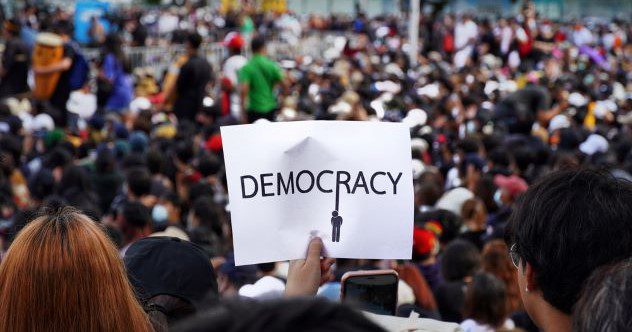The 21st century has seen its fair share of dramatic coup attempts, where groups have made bold moves to overthrow governments. These coups often unfold with a mix of suspense, conflict, and unexpected twists, making headlines around the world. Whether sparked by political disagreements, power struggles, or sheer ambition, each attempt tells a gripping story of a nation’s turbulent moment in history.
From Latin America to Africa and Asia, these coups reveal just how fragile political systems can be. They showcase the lengths people will go to gain control and the fierce determination of those fighting to keep their governments intact. These events are more than just power plays—they are intense dramas with real-life consequences, affecting millions and reshaping countries.
In this list, we explore ten of the boldest coup attempts of the 21st century. Each entry dives into the chaos, the key players involved, and the aftermath that followed. These stories give us a glimpse into the volatile nature of political power and the dramatic efforts to seize it.
Related: Ten Vicious & Violent Political Feuds from American History
10 Bolivia: The High-Stakes 2024 Coup Attempt
Why the Bolivia coup attempt may not be what it seems
In June 2024, Bolivia found itself at the center of a high-stakes coup attempt that captivated the world. A faction of the military, frustrated with the government, launched a surprise attack on key government buildings in La Paz. The coup was meticulously planned, with troops deployed to strategic locations across the city.
However, the coup plotters faced unexpected resistance. Loyalist forces and civilian supporters of the government quickly mobilized, turning the streets of La Paz into battlegrounds. The clashes resulted in significant damage and numerous casualties, throwing the city into chaos.
International reactions were swift, with neighboring countries and global powers condemning the coup and calling for a peaceful resolution. Diplomatic efforts helped restore order, and the coup leaders were eventually apprehended. This bold attempt will likely leave a lasting impact on Bolivia’s political landscape, highlighting deep divisions and the ongoing struggle for stability.[1]
9 Turkey: The Night of the 2016 Failed Coup
Turkey’s failed military coup, explained
In July 2016, Turkey was thrown into chaos as a faction within the Turkish Armed Forces attempted to overthrow President Recep Tayyip Erdoğan. Tanks rolled onto the streets of Ankara and Istanbul, jets roared overhead, and soldiers took control of key infrastructure, including bridges and media outlets.
The coup plotters aimed to topple Erdoğan and restore what they claimed would be democracy and constitutional order. However, the coup faced immediate resistance. President Erdoğan, who was on vacation, used a video call to address the nation, urging people to take to the streets in defiance of the coup. Thousands responded, flooding the streets and confronting the soldiers.
The resistance from civilians, loyalist military units, and police forces turned the tide against the coup plotters. By dawn, the coup had collapsed, leaving over 300 people dead and thousands wounded. The government quickly regained control, arresting thousands of military personnel, judges, and civil servants suspected of involvement. The failed coup had a profound impact on Turkey, leading to widespread purges and a significant crackdown on dissent.[2]
8 Myanmar: The 2021 Military Takeover Shocker
Myanmar Coup Explained: Protests, Military, Min Aung Hlaing & Aung San Suu Kyi
In February 2021, Myanmar’s military staged a shocking takeover, detaining civilian leader Aung San Suu Kyi and other key figures of the National League for Democracy (NLD). The coup came just as the newly elected parliament was set to convene following a landslide victory by the NLD in the November 2020 elections. The military, alleging widespread electoral fraud, declared a state of emergency and assumed control, igniting widespread protests and international condemnation.
Thousands of people from various sectors, including students, monks, and civil servants, took to the streets in mass demonstrations against the coup. The protests were met with a brutal crackdown by the military, resulting in numerous arrests, injuries, and deaths. The situation in Myanmar quickly escalated into a humanitarian crisis, with reports of extensive human rights violations and escalating violence.
Despite international calls for restraint and the restoration of democracy, the military junta has maintained its grip on power. The coup has plunged Myanmar into ongoing turmoil, with significant impacts on its economy, social fabric, and international relations. The resilience of the Myanmar people and their continued resistance highlight the enduring struggle for democracy in the face of authoritarian rule.[3]
7 Egypt: The Dramatic 2013 Military Coup
Egypt’s 2013 military coup, briefly explained
On June 30, 2013, millions of Egyptians took to the streets in massive protests against President Mohamed Morsi, marking the first anniversary of his inauguration. The demonstrators accused Morsi and his Muslim Brotherhood of consolidating power and failing to address economic issues. The scale of the protests prompted the military, led by General Abdel Fattah el-Sisi, to issue an ultimatum, demanding Morsi address the people’s grievances within 48 hours.
When Morsi failed to comply, the military stepped in on July 3, 2013, removing him from power, suspending the constitution, and appointing an interim government. This intervention was celebrated by Morsi’s opponents, who saw it as a necessary action to restore stability and democracy in Egypt. However, Morsi’s supporters viewed the coup as a betrayal of democratic principles, leading to widespread violence and clashes.
The aftermath of the coup saw a brutal crackdown on the Muslim Brotherhood and other dissenters, with thousands arrested and many killed in the violence that ensued. The 2013 military coup remains a significant event in Egypt’s modern history, reflecting the deep divisions within the country and the ongoing struggle between authoritarianism and democratic aspirations.[4]
6 Venezuela: The Chaotic 2002 Coup Attempt
🇻🇪 Hugo Chavez and the coup that never happened
In April 2002, Venezuela was thrown into turmoil when a coup briefly ousted President Hugo Chávez. Triggered by escalating tensions and protests, a coalition of military officers, business leaders, and opposition politicians detained Chávez and installed Pedro Carmona as interim president. The move followed a deadly confrontation in Caracas during massive anti-government protests on April 11.
The coup unraveled swiftly as Chávez’s supporters, including loyalist military factions and the urban poor, demanded his return. Within 47 hours, Carmona’s government collapsed, and Chávez was reinstated. This brief coup attempt exacerbated Venezuela’s political polarization and set the stage for continued instability. The 2002 coup remains a critical event in Venezuela’s history, illustrating the deep divisions and volatility within the nation.[5]
5 Thailand: The 2006 Military Power Grab
Life after Thailand’s Splendid Little Coup
In September 2006, Thailand’s political scene was shaken when the military executed a coup to remove Prime Minister Thaksin Shinawatra. While Thaksin was attending the United Nations General Assembly in New York, military forces led by General Sonthi Boonyaratglin seized government buildings, declared martial law, and suspended the constitution. Thaksin, accused of corruption and authoritarianism, was left stranded abroad as the coup unfolded.
The coup received a mixed reaction within Thailand. Some citizens, frustrated with Thaksin’s alleged corruption and abuses of power, supported the military’s actions, hoping for a return to stability. However, many others condemned the coup as a severe setback for Thailand’s democratic process. The new military-installed government promised reforms, including drafting a new constitution and holding elections, but political tensions remained high.
This coup marked the beginning of a prolonged period of political instability in Thailand. It highlighted the deep-rooted divisions between pro- and anti-Thaksin factions and set the stage for subsequent coups and ongoing power struggles. The 2006 military takeover underscored the fragility of Thai democracy and the enduring influence of the military in the nation’s politics.[6]
4 Honduras: The Controversial 2009 Coup D’état
Military coup in Honduras
In June 2009, Honduras faced a major constitutional crisis when President Manuel Zelaya was ousted by the military and flown to Costa Rica. This dramatic event followed Zelaya’s insistence on holding a referendum to amend the constitution, which the Supreme Court and Congress deemed illegal. The military’s intervention, justified by claims of preserving democracy, led to the installation of Roberto Micheletti as interim president.
The international community, including the United Nations and the Organization of American States, condemned the coup and called for Zelaya’s reinstatement. Inside Honduras, the removal of Zelaya sparked widespread protests and violent clashes between his supporters and security forces. Micheletti’s government faced intense scrutiny and resistance, both domestically and internationally, during its interim rule.
The 2009 coup exposed deep political and social divisions within Honduras. It also highlighted the fragility of its democratic institutions as the country grappled with the fallout from this crisis. The long-term effects of the coup continue to influence Honduran politics, underscoring ongoing tensions and challenges to democratic governance.[7]
3 Zimbabwe: The 2017 Military Intervention That Toppled Mugabe
The military coup in Zimbabwe, explained
In November 2017, Zimbabwe witnessed a historic change when the military intervened to end Robert Mugabe’s 37-year rule. The crisis began when Mugabe dismissed his vice president, Emmerson Mnangagwa, fueling fears that Mugabe’s wife, Grace, was being positioned to succeed him. In response, General Constantino Chiwenga led a military operation, placing Mugabe under house arrest and taking control of key state institutions.
The military insisted it was not a coup but a move to remove “criminals” around Mugabe. Massive public demonstrations erupted, with Zimbabweans celebrating the potential end of Mugabe’s autocratic rule. On November 21, amid impeachment proceedings, Mugabe resigned. Mnangagwa returned from exile and was sworn in as president, promising political and economic reforms. This intervention, while ending Mugabe’s reign, left lingering questions about military influence in Zimbabwean politics.[8]
2 Sudan: The 2019 Overthrow of al-Bashir
Military coup ousts Sudanese President Omar al-Bashir
In April 2019, Sudan’s political landscape was dramatically altered when the military deposed President Omar al-Bashir after months of intense protests. Sparked by economic hardships, the demonstrations quickly evolved into a nationwide call for al-Bashir’s removal after 30 years in power. The military, led by General Abdel Fattah al-Burhan, took control, promising a transition to civilian rule.
The coup was both a moment of celebration and caution for Sudanese citizens. While it marked the end of al-Bashir’s authoritarian regime, the public continued to demand a civilian government. Protests persisted until a power-sharing agreement was reached between the military and civilian leaders, aiming to guide Sudan towards democratic elections. The 2019 overthrow of al-Bashir remains a crucial step in Sudan’s quest for democracy.[9]
1 Mali: The Tumultuous 2020 Military Coup
Mali military coup: What does it mean for the country’s future? | DW News
In August 2020, Mali’s political scene was upended when the military seized power from President Ibrahim Boubacar Keïta after months of public discontent. The protests, fueled by frustrations over government corruption, economic decline, and escalating violence from jihadist groups, culminated in soldiers detaining Keïta and compelling him to resign. The coup leaders, organized under the National Committee for the Salvation of the People (CNSP), vowed to restore stability and facilitate a transition to civilian rule.
The international community reacted strongly, with bodies like the African Union and ECOWAS condemning the coup and implementing sanctions, demanding a swift return to constitutional order. Despite these pressures, the CNSP remained in control, eventually negotiating with local political factions to form a transitional government. This interim administration, led by Bah N’Daw, a former defense minister, was mandated to steer the country toward new elections within 18 months.
Mali’s 2020 coup underscored the nation’s deep-seated issues, including political instability, economic hardship, and persistent security threats. The coup’s aftermath revealed the fragile state of Mali’s democracy and the complexities involved in achieving lasting governance and peace.[10]
fact checked by
Darci Heikkinen
>>> Read full article>>>
Copyright for syndicated content belongs to the linked Source : Listverse – https://listverse.com/2024/06/29/the-10-boldest-coup-attempts-of-the-21st-century/































